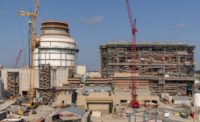Interest groups are weighing in on a new rule the Nuclear Regulatory Commission is considering that addresses alternating-current electrical power loss at U.S. nuclear reactors.
Following the March 2011 Fukushima Daiichi disaster, the NRC began to take a hard look at its own station-blackout rule. On March 20, it published a notice to open comment to proposed revisions in the station-blackout rule. Further, a task force spotlighted station-blackout strategies as a priority last summer.
Industry groups, meanwhile, are moving ahead of the possible new rule with a so-called FLEX safety strategy. The initiative, which the Nuclear Energy Institute (NEI) launched in January, builds on lessons learned from Fukushima. FLEX calls for providing additional layers of backup power, including generators, battery packs, pumps, air compressors and battery chargers, in multiple locations.
"What we're doing with the FLEX strategy, in dealing with mitigation of beyond-design-basis external events, answers questions regarding extended loss of AC power," says Adrian Heymer, NEI executive director of strategic programs.
Heymer notes that station-blackout mitigation will be addressed in other proposed regulations and says the existing rule "is good and should be left as is."
Heymer says he expects that any changes would affect only existing, older reactors. He contends that new designs sufficiently address station blackouts. "If you look at a design like the [Westinghouse] AP1000, it has the capability to go at least 72 hours without AC power," he adds. "Only a few measures would be required to go beyond that."
The NRC has directed its staff in recent years to use performance-based standards, rather than a prescriptive approach, in new or revised regulations. But there's a risk the result could be too vague, says Edwin Lyman, senior scientist at the Union of Concerned Scientists. Lyman says inspections of U.S. plants after the Fukushima disaster proved the current rule is insufficient.
The commission aims to wrap the blackout rule-making by April 2014.



Post a comment to this article
Report Abusive Comment